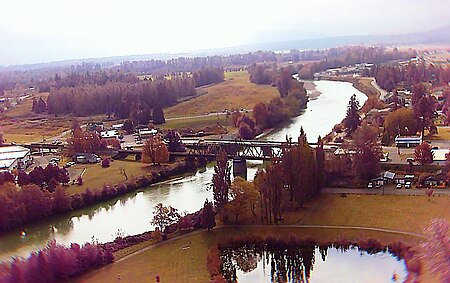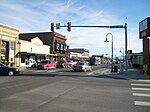Nooksack River

The Nooksack River is a river in western Whatcom County of the northwestern U.S. state of Washington, draining extensive valley systems within the North Cascades around Mount Shuksan, Mount Baker and the Twin Sisters, and a portion of Fraser Lowland south of the Canada–United States border. The river proper begins with the merging of three main tributaries, namely the North Fork, Middle Fork and South Fork, near Deming. All three forks originate in the Mount Baker Wilderness, and the North Fork, the longest of the three, is sometimes considered the main river. The Nooksack is approximately 75 miles (121 km) in total length measuring from the North Fork headwaters. The lower Nooksack flows as a northerly loop through the fertile southern Fraser Lowland agricultural area before emptying into Bellingham Bay and, via the Strait of Juan de Fuca and the Strait of Georgia, communicating with the Pacific Ocean.
Excerpt from the Wikipedia article Nooksack River (License: CC BY-SA 3.0, Authors, Images).Nooksack River
Lummi Shore Road,
Geographical coordinates (GPS) Address Nearby Places Show on map
Geographical coordinates (GPS)
| Latitude | Longitude |
|---|---|
| N 48.774722222222 ° | E -122.59916666667 ° |
Address
Lummi Shore Road
Lummi Shore Road
98262
Washington, United States
Open on Google Maps






